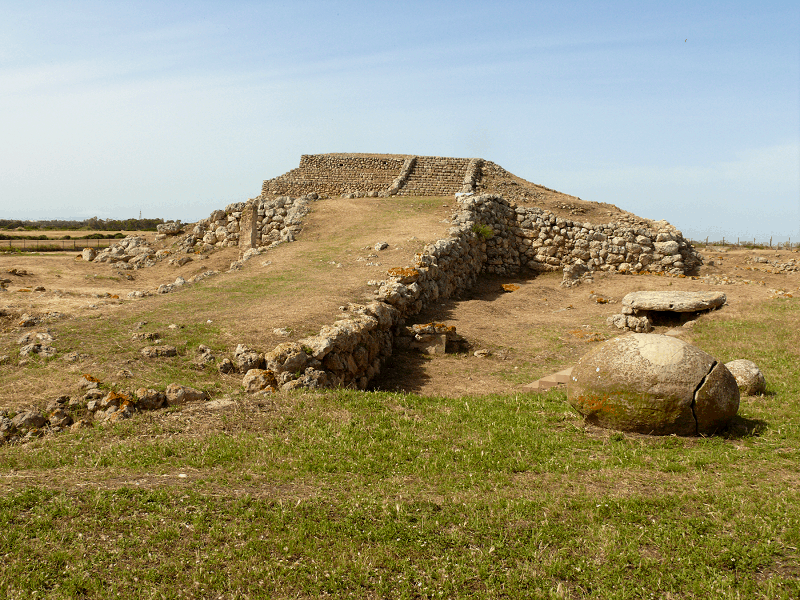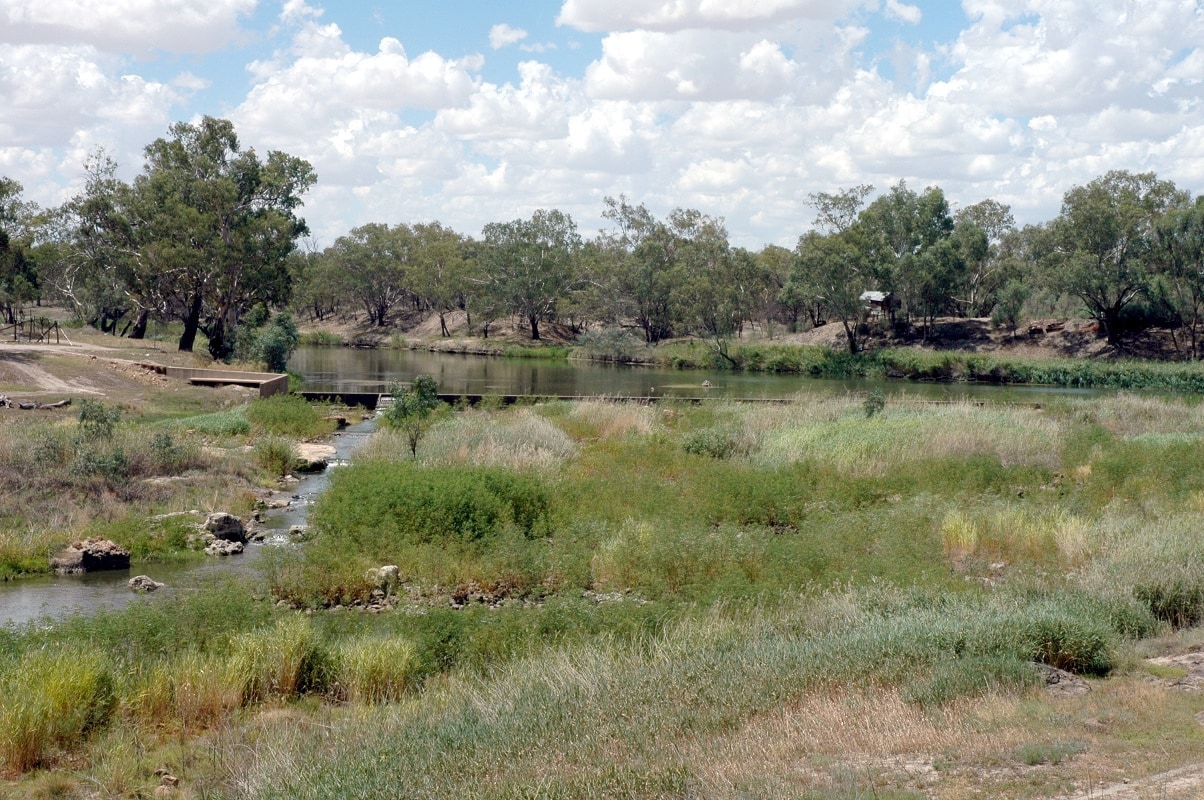Most of the structures on this list date back to the Neolithic era (which started around 15,200 BCE and ended sometime between 4500 – 2000 BCE). However the two oldest existing structures in the world, predate this time period, which is considered to be when the first civilizations (by modern standards) emerged.
These early structures were typically made of stone and used as burial chambers or temples. Most of these sites have become historic national treasures and provide insight into the lives of early humans. All of these structures still stand today and many have been restored over the years.
10. Listoghil
Date: c.3550 BCE
Location: County Sligo, Ireland
Use: Passage tomb

Listoghil (or Carrowmore 51) is the large central monument that is a part of the Carrowmore group of prehistoric tombs found in County Sligo, Ireland. Sometime during the 1800s, the site was damaged by workmen removing rocks for “road metal.”
After the workers uncovered the central tomb chamber, the site’s destruction stopped. Listoghil is the only part of the Carrowmore passage tombs believed to have had a cairn or covering mound of stones.
In the late 1990s, the site was partly excavated by Swedish archaeologist, Goran Burenhult, who dated bones and carbon material and also uncovered the still intact kerb, or stone ring built to enclose barrow over a chamber tomb. The site was restored by the Office of Public Works and a new cairn was placed over the tomb.
Did You Know?
The roof slab of the cairn at Listoghil has concentric circular carvings on it that are only visible in certain light. This is a rare example of Irish megalithic art outside of the Boyne valley.
9. West Kennet Long Barrow
Date: c.3650 BCE
Location: Wiltshire, England
Use: Tomb

The West Kennet Long Barrow is a Neolithic tomb found in Wiltshire, England that dates back to about 3650 BCE. Researchers believe that the tomb was used for about 1,000 years and was sealed sometime around 2000 BCE – the main passage was filled with earth, stone, rubble, and debris.
Then the forecourt was blocked with sarsen boulders and a false entrance and finally, three massive sarsen blocking stones were placed across the front of the tomb. The tomb was first excavated in 1859 and then again in 1955-1956 and researchers found at least 46 individuals within the barrow, ranging from babies to elderly persons.
Did You Know?
The Neolithic people who built the West Kennet Long Barrow used oolitic limestone to fill in the gaps of the large sarsen stones. This limestone does not occur naturally in the area and must have come from the Cotswold hills located 20 – 30 miles (32.2 – 48.3 kilometers) away.
8. Ggantija Temples
Date: c.3600 – 3200 BCE
Location: Gozo, Malta
Use: Religious temple

The Ġantija Temples are the earliest of the Megalithic Temples of Malta, dating back to between 3600 – 3200 BCE. The site consists of two temples, which are older than the Egyptian pyramids, and today are listed on the UNESCO World Heritage List. The temples are believed to be part of ceremonial site used for a fertility rite – researches have found numerous statues and figurines that allude to this use.
There are also animal bones and remains as well as stone hearths that suggest rituals involving animal sacrifice were performed at the temples. The Ġgantija Temples and their surrounding areas were restored in the 2000s and a heritage park was opened in 2013.
Did You Know?
According to Gozitan folklore, the Ġgantija Temples were built by a giantess who had a child with a regular man and wanted the temples to be used as places of worship.
7. Knap of Howar
Date: c.3700 BCE
Location: Island of Papa Westray, Orkney, Scotland
Use: House

The Knap of Howar is a Neolithic site on the island of Papa Westray in Orkney, Scotland that is believed to be the oldest preserved stone house in northern Europe. The site consists of two “houses,” commonly referred to as “the farmstead,” which were built through dry stone construction with an adjoining passageway between them.
Excavations show evidence that the inhabitants of the house kept cattle, sheep, and pigs; cultivated barley and wheat; gathered shellfish and also fished for species which need to be line caught using boats. The larger building (House One) is believed to be the living quarters while House Two served as a workshop and storage space.
Did You Know?
While the Knap of Howar is close to Papa Westray’s coast today, when it was still being used, the house would have been much further inland in a wide meadow.
6. Monte d’Accoddi
Date: c.4000 – 3650 BCE
Location: Sardinia, Italy
Use: Possibly an open-air temple, ziggurat, or a step pyramid

The Monte d’Accoddi is a large stone structure located in Sardinia, Italy – it looks like a step pyramid, but is not confirmed to be a pyramid. Although the site has been extensively researched, the structure’s purpose has not been determined.
Researchers speculate that it may have been an altar, ziggurat, mound, an ancient temple, or possibly an astronomical observatory.
The site was discovered in 1954 and the structure and its surrounding areas were excavated in the 1960s.
Near the monument is a dolmen (a single chamber megalithic tomb), a prominent menhir, one of several standing standing stones that were formerly found in the vicinity, and several mysterious carved stones.
Did You Know?
Archaeologists believe that the Monte d’Accoddi was built by the Ozieri culture, a prehistoric pre-Nuragic culture that lived in Sardinia from c. 3200 to 2800 BCE.
5. Tumulus of St. Michel
Date: c.4500 BCE
Location: Carnac, France
Use: Burial mound

The Tumulus of St. Michel is a megalithic grave mound found in Carnac, France, dating back to around 4500 BCE. At 125m(410ft) long, 60m (196.85ft) wide, and 10m (32.8ft) high, the tumulus is the largest burial mound in continental Europe.
The mound was excavated in 1862 and researchers found a central vault containing fairly prestigious funerary furniture such as axes, pearls, flint tools, and sillimanite. The Tumulus of St. Michel was declared a Monument historique (French national heritage site) in 1889. Today, the St. Michel chapel is located on the tumulus’ summit.
Did You Know?
All of the objects found within the Tumulus of St. Michel are now on display at the Carnac and Vannes Polymathique museums.
4. Tumulus of Bougon
Date: c.4700 BCE
Location: Bougon, France
Use: Burial mounds

The Tumulus of Bougon or Necropolis of Bougon consists of a group of five Neolithic barrows. The barrows were built at various times between 4700 – 3500 BCE. The tumulus mounds were re-discovered in 1840 and to protect the monuments from destruction and damage, the site was acquired by the department of Deux-Sèvres in 1873.
The five barrows are notable for being different from one another as each one showcases a unique architectural style. During excavations, researchers uncovered over 200 skeletons and grave goods.
Today, the site is open to the public and a small museum which displays the archaeological finds from the tumulus is located nearby.
Did You Know?
In 1979, archaeologists conducted an experiment to figure out how the builders of the Tumulus of Bougon would have transported a 32 ton megalith from the nearby quarry – they successfully transported the stone from the quarry to the site.
3. Cairn of Barnenez
Date: c. 4850 BCE
Location: Brittany, France
Use: Passage grave

The Cairn of Barnenez (also called the Barnenez Tumulus of Barnenez Mound) is one of the oldest structures in the world and dates back to the Neolithic period. It is a stone burial chamber and is considered to be the largest megalithic mausoleum in Europe.
The cairn is made out of two burial chambers – the older one dating back to between 4850 – 4500 BCE made out of dolerite and the second one made a few hundred years later built with granite from the Île de Sterec. Megalithic art, such as wavy lines, axes, and bows, are carved into the stone chambers and passages.
Did You Know?
It is estimated that it took about 12,000 to 14,000 metric tons of stone to build the Cairn of Barnenez.
2. Theopetra Cave Wall
Date: c.21000 BCE
Location: Near Kalambaka, Thessaly, Greece
Use: Stone wall most likely used as a barrier against cold winds

Humans inhabited Theopetra Cave as far back as 130,000 years ago and various ancient peoples called the cave home during different eras. Due to so much human activity in the cave, Theopetra is a treasure trove of ancient artifacts and provides insight into the lives of early humans.
One of Theopetra Cave’s most notable features is a 23,000 year old stone wall — it is the oldest wall in the world. Archaeologists believe that the wall was built as a barrier against cold winds as its construction dates back to the last glacial age. The wall is widely cited as the oldest existing man-made structure in the world.
Did You Know?
The remains of the Theopetra Cave Wall were only discovered in 2010, using a relatively new method of dating known as Optically Stimulated Luminescence.
1. Ngunnhu Fish Traps of Brewarrina
Date: c.40,000 years ago
Location: Brewarrina, New South Wales, Australia
Use: Fish traps

The Ngunnhu Fish Traps of Brewarrina in Australia were supposedly built by the Aboriginal peoples about 40,000 years ago. However, this date is uncertain as the Aboriginals don’t keep written records.
But this date of the Ngunnhu Fish Traps coincides with recent DNA evidence that shows the Aboriginals already settled in Australia between 30,000 to 40,000 years ago. With this in mind, it’s plausible that the Ngunnhu Fish Traps of Brewarrina are tens of thousands years old, making them the oldest structures in the world.
As their name suggests, the Ngunnhu Fish Traps were used to capture fish along the Barwon River. The traps are actually a complex system of river stones arranged to form ponds and channels that catch fish as they travel downstream.
Did You Know?
According to Aboriginal legend, the Ngunnhu Fish Traps were inspired by the pelican.
OTHER POSTS YOU MAY BE INTERESTED IN












The Brewarrina Fish Traps date back to 19,000 years ago…